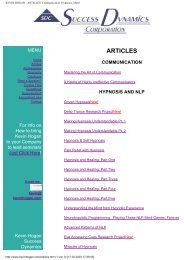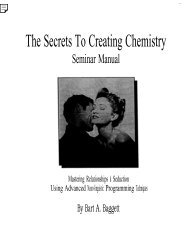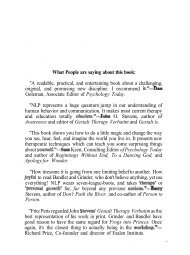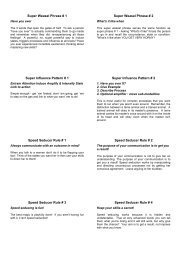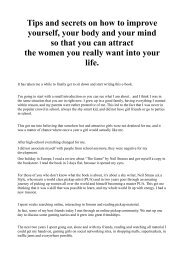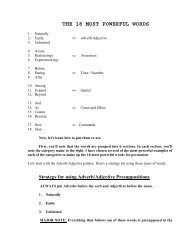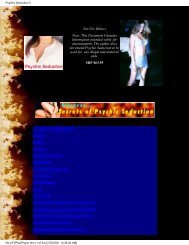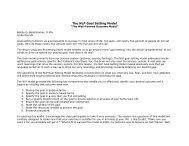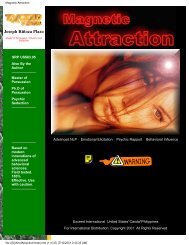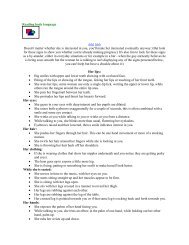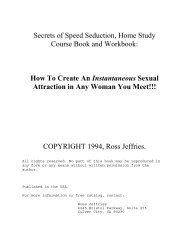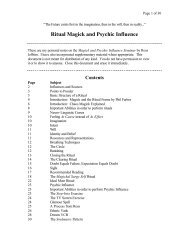A Pragmatic Guide To Communication & Change.pdf - NLP Info Centre
A Pragmatic Guide To Communication & Change.pdf - NLP Info Centre
A Pragmatic Guide To Communication & Change.pdf - NLP Info Centre
- No tags were found...
You also want an ePaper? Increase the reach of your titles
YUMPU automatically turns print PDFs into web optimized ePapers that Google loves.
creative ways, something we generally call "thinking." Thinking, however, is merely<br />
synthetic experience, extrapolations and recombinations of previously experienced<br />
material in new and unique ways.<br />
It is possible at any time to substitute synthesized elements for other sensory- based<br />
experiences in a 4-tuple. In other words, at any given moment, a person may experience<br />
combinations of internally-generated pictures, images, feelings, sounds, smells and tastes<br />
along with stimuli of external origin. The smell of a Christmas tree, for example, may<br />
originate in the external environment. However, it may instantaneously elicit internally<br />
generated visual memories,_ feelings, and sounds associated with that particular smell.<br />
25<br />
These synthesized elements in the 4-tuple are based on a person's previous experiences<br />
his past personal history, in combination with various wants and needs of the moment.<br />
Synthetic experiences are also subject to the universal modeling processes of<br />
generalization, deletion, and distortion.<br />
Internal Experience<br />
"Emotionally-laden" experiences are often elicited by cues in the external environment.<br />
They may be pleasant, as in the above example, or they may be devastating. An example<br />
of internally generated dysfunctional response to external cues is given on page 123.<br />
Figure 1 - 3 show the 4-tuple going through the Individual filter. It is at this point in the<br />
formation of the experience the perception of "one moment in time", that a person adds<br />
synthesized elements to the 4-tuple. The model shows these internally generated<br />
experiences riding ° piggyback"on the 4-tuple. For each element in a 4-tuple, a person is<br />
only aware of one aspect, either the internal or the external experience, but not both at the<br />
same time. It is also important to note that although there will always be input from the<br />
external environment (except in cases of neurological damage, such as blindness), there<br />
does not necessarily have to be an associated internally generated experience for each<br />
element<br />
22<br />
conventions are learned and integrated by an individual in much the same ways language<br />
is learned. By watching and listening to others and by being corrected when we "error,"<br />
we come to know what is expected by social convention. I,ike language, these social rules<br />
vary from generation to generation and between the subcultures that make up the larger<br />
society. Much like rules that govern language, these social constraints are powerful filters<br />
on our models of the world, affecting both perception and behavior. As the following<br />
examples will demonstrate, social constraints form some of the boundaries between what<br />
we believe to be possible and impossible, good and bad, appropriate and inappropriate,<br />
etc.<br />
In the recent past, both in this country and in parts of Western Europe, it was customary<br />
for a woman to faint or "swoon" in certain situations. In movies from that period, there<br />
was always someone in the crowd ready with smelling salts to help revive the distressed<br />
maiden. The situations in which swooning occurred were highly standardized, and the<br />
behavior was limited to only a few subcultures here and in Europe.<br />
Another highly regulated phenomenon rarely witnessed today was the "duel." This formal<br />
fight between two individuals followed a specific form dictated by social custom. Both<br />
parties played out each step of the prescribed Social Constraints<br />
I



